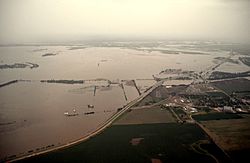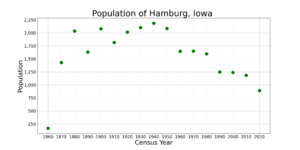Hamburg, Iowa facts for kids
Quick facts for kids
Hamburg, Iowa
|
|
|---|---|

The community on June 16, 2011 during the 2011 Missouri River floods after a levee protecting it was breached. A second levee was built and held
|
|

Location of Hamburg, Iowa
|
|
| Country | |
| State | |
| County | Fremont |
| Area | |
| • Total | 1.12 sq mi (2.91 km2) |
| • Land | 1.12 sq mi (2.91 km2) |
| • Water | 0.00 sq mi (0.00 km2) |
| Elevation | 915 ft (279 m) |
| Population
(2020)
|
|
| • Total | 890 |
| • Density | 793.23/sq mi (306.19/km2) |
| Time zone | UTC-6 (Central (CST)) |
| • Summer (DST) | UTC-5 (CDT) |
| ZIP code |
51640
|
| Area code(s) | 712 |
| FIPS code | 19-33780 |
| GNIS feature ID | 467990 |
Hamburg is a city in Fremont County, Iowa, United States. It is the most southwestern city in Iowa. Hamburg is located right next to the borders of Missouri (to the south) and Nebraska (to the west). It sits between the Nishnabotna and Missouri rivers. In 2020, about 890 people lived there. The city gets its name from the famous city of Hamburg in Germany.
Contents
History of Hamburg
Hamburg is very close to the Missouri state line. The first people who settled here actually thought they were moving to Missouri. This was after a large area of land, called the Platte Purchase, was opened up for settlement. This land used to belong to Native American tribes.
The first official settlement near Hamburg was called McKissick's Grove. It was started by three brothers: James, Cornelius, and Daniel McKissick. When Iowa became a state in 1846, a survey was done. That's when the settlers found out they were in Iowa, not Missouri!
The McKissick brothers were also involved in another interesting border story. They bought McKissick Island, which was about a mile south of Hamburg. They thought the island was part of Nebraska territory. But in 1867, the Missouri River changed its path. This made the island physically connect to Missouri by land, and it was cut off from Nebraska by the main river channel. Both Missouri and Nebraska claimed the island. In 1904, the U.S. Supreme Court decided it belonged to Nebraska. However, the states didn't officially agree until 1999. During this time, students from the Nebraska island had to travel through Missouri to go to school in Hamburg, Iowa!
Hamburg was officially planned out in 1857 by Augustus Borchers. He was born near Hamburg, Germany, and named the new city after his hometown. Hamburg officially became a city on April 1, 1867. Around the same time, the Council Bluffs and St. Joseph Railroad reached the city. A second railroad, from Red Oak, Iowa, arrived in 1870.
In 1948, Alex and Arthur Vogel started Vogel and Son Popcorn Company. The company grew so much that they bought the city's old water tower and train station. These buildings were used to store popcorn, holding over a million pounds! In 1960, Hamburg started its "Popcorn Days" festival. This festival replaced an older one that celebrated peonies (a type of flower). Today, Vogel Popcorn is owned by ConAgra Foods, a big food company. But its main office is still in Hamburg. Their popcorn is used in popular brands like Act II and Orville Redenbacher's.
Hamburg often gets attention when the Missouri River floods. This happened most recently during the 2019 Midwestern U.S. floods. The floods left the city without sewage, water, or gas. In 2012, people in Hamburg tried to raise money to fix their flood control levee (a wall built to stop floods). They made a fun flash mob dance video to the song "Proud Mary." However, they didn't get the $5 million they needed for the repairs.
Geography and Climate
Hamburg covers about 1.10 square miles (2.91 square kilometers) of land. There is no water area within the city limits.
Hamburg's Climate
The weather in Hamburg can change a lot! The hottest temperature ever recorded was 109°F (43°C) on July 21, 1974. The coldest temperature was -25°F (-32°C) on December 23, 1989. Usually, July is the warmest month, and January is the coldest.
| Climate data for Hamburg, Iowa | |||||||||||||
|---|---|---|---|---|---|---|---|---|---|---|---|---|---|
| Month | Jan | Feb | Mar | Apr | May | Jun | Jul | Aug | Sep | Oct | Nov | Dec | Year |
| Record high °F (°C) | 69 (21) |
82 (28) |
91 (33) |
96 (36) |
100 (38) |
105 (41) |
109 (43) |
103 (39) |
102 (39) |
94 (34) |
83 (28) |
72 (22) |
109 (43) |
| Mean daily maximum °F (°C) | 33 (1) |
39 (4) |
51 (11) |
63 (17) |
73 (23) |
82 (28) |
86 (30) |
84 (29) |
78 (26) |
66 (19) |
50 (10) |
36 (2) |
62 (17) |
| Daily mean °F (°C) | 24 (−4) |
29 (−2) |
40 (4) |
52 (11) |
63 (17) |
72 (22) |
76 (24) |
74 (23) |
66 (19) |
54 (12) |
40 (4) |
27 (−3) |
51 (11) |
| Mean daily minimum °F (°C) | 14 (−10) |
19 (−7) |
28 (−2) |
40 (4) |
52 (11) |
62 (17) |
66 (19) |
64 (18) |
54 (12) |
42 (6) |
30 (−1) |
18 (−8) |
41 (5) |
| Record low °F (°C) | −22 (−30) |
−23 (−31) |
−17 (−27) |
8 (−13) |
28 (−2) |
41 (5) |
44 (7) |
42 (6) |
28 (−2) |
14 (−10) |
−9 (−23) |
−25 (−32) |
−25 (−32) |
| Average precipitation inches (mm) | 0.82 (21) |
0.95 (24) |
2.44 (62) |
3.36 (85) |
4.51 (115) |
4.22 (107) |
5.08 (129) |
3.85 (98) |
3.61 (92) |
2.63 (67) |
2.09 (53) |
1.10 (28) |
34.66 (881) |
| Average snowfall inches (cm) | 6.5 (17) |
6.1 (15) |
5.9 (15) |
1.7 (4.3) |
0 (0) |
0 (0) |
0 (0) |
0 (0) |
0 (0) |
0.5 (1.3) |
3.1 (7.9) |
7.1 (18) |
30.9 (78.5) |
People in Hamburg
| Historical populations | ||
|---|---|---|
| Year | Pop. | ±% |
| 1860 | 167 | — |
| 1870 | 1,431 | +756.9% |
| 1880 | 2,036 | +42.3% |
| 1890 | 1,634 | −19.7% |
| 1900 | 2,079 | +27.2% |
| 1910 | 1,817 | −12.6% |
| 1920 | 2,017 | +11.0% |
| 1930 | 2,103 | +4.3% |
| 1940 | 2,187 | +4.0% |
| 1950 | 2,086 | −4.6% |
| 1960 | 1,647 | −21.0% |
| 1970 | 1,649 | +0.1% |
| 1980 | 1,597 | −3.2% |
| 1990 | 1,248 | −21.9% |
| 2000 | 1,240 | −0.6% |
| 2010 | 1,187 | −4.3% |
| 2020 | 890 | −25.0% |
| Source: and Iowa Data Center Source: |
||
2020 Census Information
In 2020, the census counted 890 people living in Hamburg. There were 365 households and 245 families. This means there were about 793 people per square mile.
Most of the people in Hamburg (about 93.6%) were White. A small number were Black, Native American, Asian, or Pacific Islander. About 3.4% of the population were Hispanic or Latino.
About 23.3% of households had children under 18 living with them. The average age in Hamburg was 45.5 years old. About 23.3% of residents were under 20 years old, and 22.9% were 65 or older. The city had slightly more males (50.9%) than females (49.1%).
2010 Census Information
In 2010, the census showed that 1,187 people lived in Hamburg. There were 514 households. The population density was about 1079 people per square mile.
About 94.2% of the people were White. Other groups included African American, Native American, Asian, and Pacific Islander. About 6.2% of the population was Hispanic or Latino.
About 28.2% of households had children under 18. The average age in Hamburg was 41 years. About 23.5% of residents were under 18, and 19.9% were 65 or older. The city had a nearly equal number of males (50.1%) and females (49.9%).
Economy and Jobs
Hamburg is home to the main office of Vogel Popcorn. This company says it provides 52% of all the popcorn grown in the United States! That's a lot of popcorn!
Schools in Hamburg
The Hamburg Community School District runs a public school for students from Pre-Kindergarten to 8th grade. After 8th grade, the district pays for high school students to attend schools in other nearby districts. A new type of high school, called a charter high school, opened in Hamburg in 2022.
From 2011 to 2016, Hamburg shared school services with the Farragut Community School District. Before 2015, Hamburg high school students went to Farragut. After 2015, all middle and high school students from Hamburg went to Farragut. Nishnabotna High School in Farragut became the high school for both communities. However, the Farragut district closed in 2016. After that, the Hamburg district became a K-8 district again, sending its high school students to other places.
Famous People from Hamburg
- Betty Bennett, a singer.
- Julie Kushner, a state senator in Connecticut, lived in Hamburg before moving to Lincoln, Nebraska.
- William Benjamin Polk, an Illinois state representative, was born in Hamburg.
- Dani Reeves, editor-in-chief of Deluxe Version magazine and owner of Models Access. She is a world-renowned model who was born and grew up in Hamburg.
Images for kids
See also
 In Spanish: Hamburg (Iowa) para niños
In Spanish: Hamburg (Iowa) para niños



